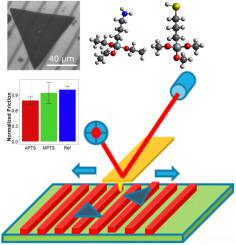Extreme Mechanics Letters ( IF 4.3 ) Pub Date : 2020-09-25 , DOI: 10.1016/j.eml.2020.100996 Weibing Chen , Chenwei Tang , Tianyi Li , Xiaolong Zou , Jing Zhang , Shuai Jia , Jiangtan Yuan , Antony George , Dmitri Voronine , Pulickel Ajayan , Qunyang Li , Ling Hao , Jun Lou

|
In this report, we utilize the heterostructures of monolayer MoS2 and self-assembled monolayers (SAMs) of organic molecules as a platform to understand how carrier density of nanomaterials affects their friction behaviors. Previous studies on the friction of two-dimensional materials have explored the effect of lattice structures and morphologies. Given the same normal force and scanning speed of the AFM tip, we observe the sliding friction of high-quality n-type monolayer MoS2 could be reduced by SAMs. The friction tunability is attributed to the charge transfer from MoSto SAMs, which modulated the carrier density and hence the carrier-mediated friction behaviors in 2D MoS2. ab initio simulations and nanoscale mapping of work functions support this hypothesis. These SAMs-based heterostructures provide a potential tool to control friction in low-dimensional materials, and also an original perspective on the effect of electron–phonon coupling on friction at nanoscale.
中文翻译:

通过控制界面化学可调节单层MoS 2的摩擦
在本报告中,我们利用有机分子单层MoS 2和自组装单层(SAMs)的异质结构作为了解纳米材料的载流子密度如何影响其摩擦行为的平台。先前对二维材料摩擦的研究已经探索了晶格结构和形态的影响。给定相同的法向力和AFM尖端的扫描速度,我们观察到SAM可降低高质量n型单层MoS 2的滑动摩擦。摩擦可调性归因于来自MoS的电荷转移SAMs,它可以调节2D MoS 2中的载流子密度,进而调节载流子介导的摩擦行为。从头开始进行的仿真和工作功能的纳米级映射支持该假设。这些基于SAMs的异质结构为控制低维材料的摩擦提供了一种潜在的工具,并且提供了电子-声子耦合对纳米级摩擦的影响的原始观点。









































 京公网安备 11010802027423号
京公网安备 11010802027423号